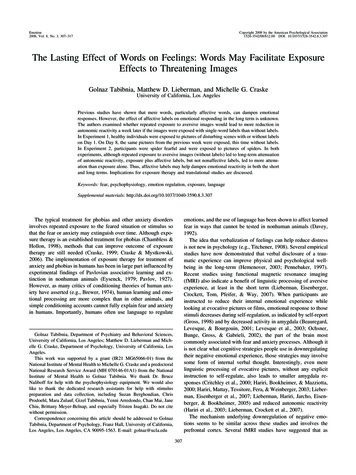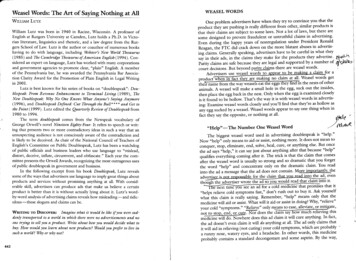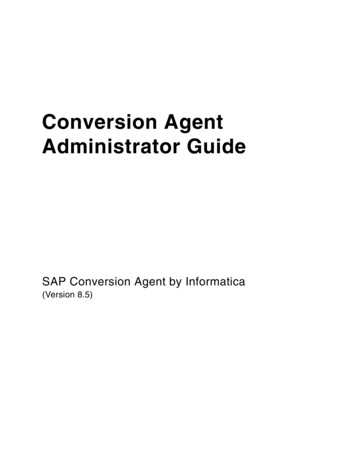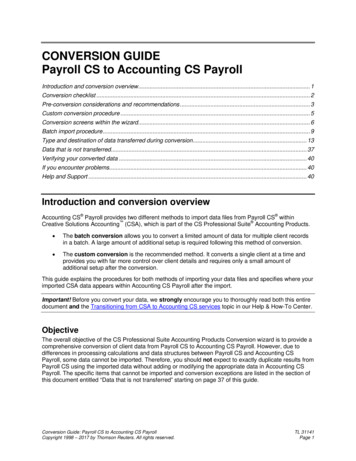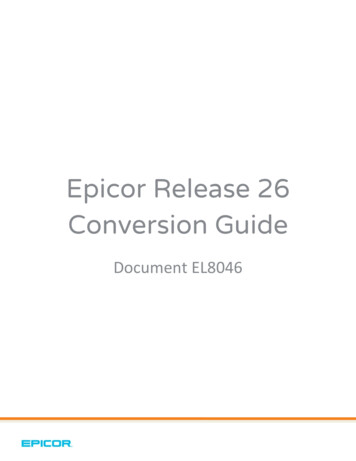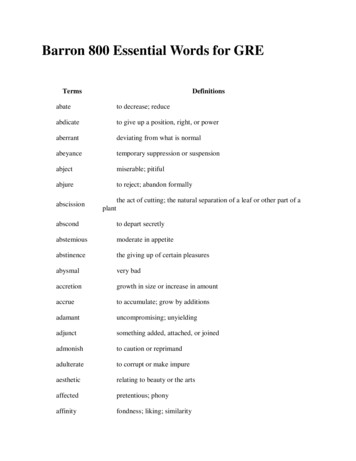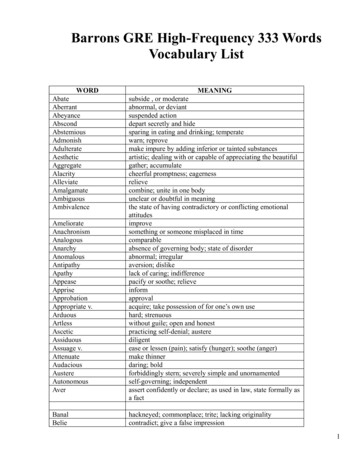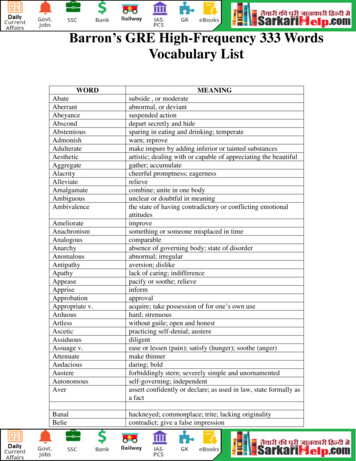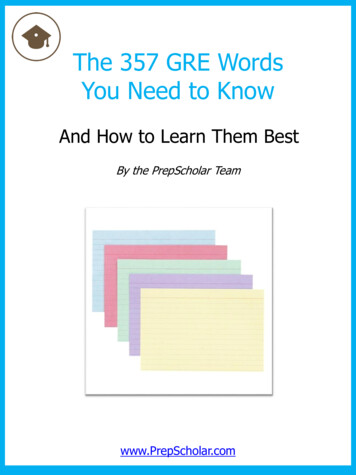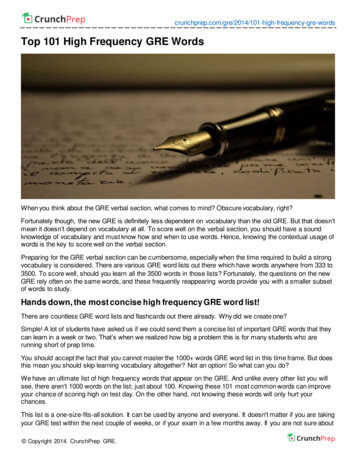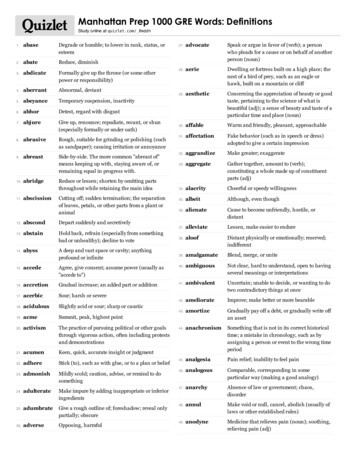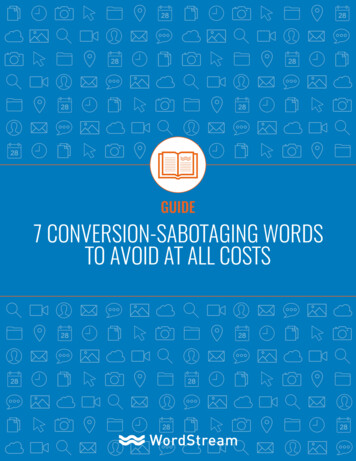
Transcription
GUIDE7 CONVERSION-SABOTAGING WORDSTO AVOID AT ALL COSTS
INTRODUCTIONWords matter. People may not read everything, but they do scan. And they processinformation subconsciously at lightning speeds to determine if they’ll click or bounce withina few fractions of a second.While some words, like “Submit” on your button, may seem innocent enough. they could becosting you dearly, turning away visitors in droves.Here’s why, along with a few other conversion-sabotaging words you need to replace in youremails, ads, and landing pages ASAP.CONVERSION KILLER #1: “SUBMIT”“Submit” is a derivation of submission. And therein lies the problem.We ain’t talkin’ kinky 50 Shades of Grey stuff, but a negative connotation with yielding tosomeone or something superior. People, as a general rule, don’t like yielding. (Rememberthat whole Revolution bit?)Especially when even the slightest suspicion of required payment might be involved.This was proven definitively years and years ago by Dan Zarella and HubSpot. They took alook at the conversion rates of over 40,000 customer landing pages and quickly noticed ahuge discrepancy.7 CONVERSION-SABOTAGING WORDS TO AVOID AT ALL COSTS02
When CTA buttons included the word “submit,” conversion rates tended to drop immediatelyby a few percentage points.To further validate, they queued up another test that would rotate CTA text randomly betweena few different options. Here’s what they found:Unsurprisingly, at this point, the word “submit” performed worse than a few other commonCTA text options like “click here” or “go.”The hypothesized reasoning is that these other variations feel much less committal and implya lower investment of time and effort.7 CONVERSION-SABOTAGING WORDS TO AVOID AT ALL COSTS03
The negative connotation is one problem. But another is the vague, generic nature of theword.In general, the best CTA’s are as specific and actionable as possible. That means you startwith a verb, or action oriented word, that describes what a person’s going to get (e.g., “ClickHere to Get My Report”).Here’s why generic quickly devolves into meaningless.CONVERSION KILLER #2: “SYNERGY”What’s the fastest way to learn terrible copywriting?Get an MBA.Because in just a few short weeks, you’ll find yourself spewing out “synergy,” “competencies,”and a host of other clichéd, meaningless words that have old professors nodding their headsin approval. (This, coming from someone who has their MBA.)As evidence, go visit almost any B2B website outside of marketing and advertising.Your eyes will glaze over, your face will contort, and a sudden bout of narcolepsy might hit atany moment.Many times, clients and bosses don’t notice anything wrong at first either. They’ve beendrinking the Kool-Aid too long, like your crazy cat-lady aunt who doesn’t notice that her housereeks of cat nip, hair balls, and litter boxes.Thankfully, the kind people from Unbounce came out with the amazing Dejargonator toquickly and humorously diagnose these issues for the people we answer to.The problem with “best in class” and all other common business jargon (besides the fact thatit also appears on every competitor’s website) is that customers can smell the BS from a mileaway.The best explanation comes from Peep at ConversionXL who points to cognitive fluency and“the heuristic that Easy True.”7 CONVERSION-SABOTAGING WORDS TO AVOID AT ALL COSTS04
Sounds stupid, right? But Peep points to research that shows easily pronounceable companynames perform better in stock markets (hardly the barometer of rational decision making),and simple fonts are more believable.In other words, as the Boston Globe points out, “it turns out that people prefer things that areeasy to think about to those that are hard.”But wait, there’s more!The first problem is that the average person’s reading comprehension ain’t that good. Soanything above a 7th or 8th grade reading level will be too difficult and complex (which is like,really low dude).The solution in most cases? Cut the BS. Rewrite anything with thefaintest resemblance to what you learned in skool school.The second, is that people aren’t focusing or reading online; they’re scanning andmultitasking and browsing and tweeting while also (kinda) looking at your page.The solution in most cases? Cut the BS. Rewrite anything with the faintest resemblance towhat you learned in skool school.7 CONVERSION-SABOTAGING WORDS TO AVOID AT ALL COSTS05
CONVERSION KILLER #3: “SPAM”No, not the canned mystery meat kind. The graymail kind that your customers are alreadyoverwhelmed with.They’re being bombarded with hundreds of emails each day. Trillions are being sent bymarketers each year.So you’d think, logically speaking, that assuring visitors you won’t spam them would helpconversions. Right?Unfortunately that’s not the case. “Spam” is a huge stop word — or no no — that causespeople to become apprehensive and hesitate.A test carried out by Michael Aargaard showed the surprising ramifications. He added theseemingly harmless line of “100% privacy — We will never spam you” in between the formfields and submission button.Typically, these extra credibility indicators surrounding a CTA can help to give conversionsa nice little boost. But not in this case.Huh. Strange. You’d think a statement assuring people of their privacy would help. But thistime it backfired by over 18%.So, Michael switched it up.7 CONVERSION-SABOTAGING WORDS TO AVOID AT ALL COSTS07
He wanted to reinforce the same message, but alter the wording to change from a negativeconnotation (i.e. bringing up something like “spam” that people weren’t really consideringbefore) to a positive one.The winning variation provided a 19.47% lift, landing on: “We guarantee 100% privacy. Yourinformation will not be shared.”Michael has even repeated this process several times, finding similarly poor results whenplacing the possibility of “spam” in people’s minds.7 CONVERSION-SABOTAGING WORDS TO AVOID AT ALL COSTS08
The lesson?Avoid words with a negative connotation (as we saw with “submit”) in general, and useadditional messaging to reinforce the positive aspects of what someone is about to get.CONVERSION KILLER #4: “WE”“We” opens a door. It’s like the gateway drug of bad copywriting.One small hit, and you’re quickly off to dabbling with bigger, badder things.While it might seem harmless at the time, “we” puts you on a path to jonesing for a fix of“synergy” and “best in class” in no time.But keep in mind, that as a general rule, people don’t care about you. Instead, they want a“better version of themselves.”This is especially so for all those visiting your site at the top of the funnel, who haven’trealized a need for your product or service yet. They’re Googling solutions for drilling a holein their wall so they can hang a picture they’re not looking for a drill (just yet).That means the focus of messagingshould be centered around said problemand solution, not a tool, product or service.7 CONVERSION-SABOTAGING WORDS TO AVOID AT ALL COSTS09
Joanna Wiebe says it goes back to trust. Or lack thereof.She points to a quote from Rohit Bhargava on Likeonomics: “The first and most basic reasonfor distrust is because there are so many companies and people who choose to lie to useither by making misleading claims or simply by hiding the truth.”Instead of “we”, Joanna recommends:1. Begin with “you” or2. Begin with no pronoun at all (like a question or a command / call to action)CONVERSION KILLER #5: “YOUR”The copy on most websites is written in the second person. And that’s a good thing!Copywriters are taught to use “you” instead of “they” when explaining the benefits derivedfrom the latest product or service.Take the completely hypothetical example of writing a blog post that discusses which wordshurt conversions. To drive your points home for maximum resonance, you would write tipsand takeaways to a specific audience by speaking to “you” as much as possible.But as always, there are exceptions.When focusing on a CTA or specific conversion event, the “possessive determiner” shouldswitch back to first person.When focusing on a CTA or specific conversion event, the “possessivedeterminer” should switch back to first person.Another test from Michael Aagaard proves the point. Michael initially thought that “your” in theCTA button copy would work best. It’s commonplace all over the interwebs after all.But here’s what he found.7 CONVERSION-SABOTAGING WORDS TO AVOID AT ALL COSTS10
Almost a 25% difference, just by switching a single word.He then repeated this process on an Unbounce landing page, switching “your” free trial with“my” free trial and saw similarly significant results.7 CONVERSION-SABOTAGING WORDS TO AVOID AT ALL COSTS11
Most landing pages and blog posts should write directly to a single person, using “you” and“your” liberally.However When writing CTA copy, switch to “my” to give people ownership of the benefit they’re aboutto receive.CONVERSION KILLER #6: “FREE”You’d think, on the surface, that “free” increases conversions. And it does in most cases.The last example a few seconds ago used a “free trial” to generate more interest (and clicks).But as always, there’s exceptions.The first (albeit tiny) issue is that the word “free” can trip up spam filters in email messaging.The second, bigger problem though is a curious case of over optimization.For example, less form fields will typically mean a higher conversion rate. Just by whittlingdown your landing page form fields from the oppressively long 11 to only four you can boostconversions by 120%.The problem is that more conversions isn’t always better.A Totango study showed that 70% of the people who sign up for free trials are useless, withonly around 20% of those actively evaluating the product.Software company Moz found this out years ago, where the most profitable customers didn’tconvert on the first or second visit, but only after 8 visits. “Many, many visits are oftencorrelated with high purchase prices,” Rand Fishkin reported.So while the word “free” can (and will) increase initial conversions, you should be optimizingfor sales and revenue — not vanity metrics like leads or impressive (but hollow) conversionrates.7 CONVERSION-SABOTAGING WORDS TO AVOID AT ALL COSTS12
Robert from Neuromarketing says: “if you are trying to encourage sampling of a product thatappeals to a specific audience a very modest charge will throttle demand but will eliminatemost samplers who have no use for the product.”CONVERSION KILLER #7. “SAVE TIME & MONEY”So far we’ve seen that vague, meaningless, overly generic phrases are bad for conversions.The culmination of them all — the cherry on top and the pièce de résistance — is “save timeand money.”This simple, albeit ever-present phrase is a (non)favorite of Joanna Wiebe’s, who lovinglyrefers to it as “lazy ass messaging.”Yes, this seemingly harmless phrase raises vitriol in seemingly one of the nicest peoplearound the interwebs. Why?Because it takes a piece of everything bad from the previous six words and rolls them up intoone terrifyingly conversion-repellent Frankenstein.In other words, it breaks one of the very first rules of copywriting that says you should writeto a particular audience. And Joanna shows in the last link that people either value one or theother, not both equally.7 CONVERSION-SABOTAGING WORDS TO AVOID AT ALL COSTS13
The easiest solution isn’t actually a copywriting trick at all, but a strategy one. Employ inboundfunnel segmentation to try your hardest at getting only one audience to a dedicated page (bylinking your content to a specific acquisition channel or segment).But what if there’s no way around it? What if you HAVE to cater to multiple audiences – likeon your homepage?Then roll up your sleeves and dig a little deeper into who you’re speaking to, and what theyvalue most.Again, Joanna gets all the credit with her flashy Venn diagram skillz:7 CONVERSION-SABOTAGING WORDS TO AVOID AT ALL COSTS14
The key is to ferret out those few ingredients that make your offering awesome & unique,which both audiences value.You want the stuff that overlaps, which will help you create a specific value proposition thatreinforces your primary aim (of driving conversions), while avoiding the same generic crapshowing up on each of your competitor’s websites.IN CONCLUSION.Not every successful landing page is a long-form squeeze page with thousands uponthousands of words. Many, if not most, are just a few simple lines with a killer headline andstrong CTA.In these cases, making each and every word work its hardest is imperative. You literally andfiguratively can’t afford words and phrases that don’t pull their weight.Online, that includes “stop words” and words which turn the focus away from your audienceand selfishly onto yourself.Thankfully, many people have already done the research and testing to show us the light. Wejust need to be aware of it and then follow it.7 CONVERSION-SABOTAGING WORDS TO AVOID AT ALL COSTS15
ABOUT WORDSTREAMWordStream Inc. provides software and services that help marketers get the maximum results from theironline marketing efforts. WordStream’s easy-to-use software allows for more effective paid search and socialcampaigns with the 20-Minute Work Week, a customized workflow that guides marketers through steps thatcan greatly improve their AdWords, Bing, Yahoo, and Facebook campaigns, plus tools for call tracking, keywordoptimization, and more. WordStream also offers an award-winning free PPC tool, the AdWords PerformanceGrader, which evaluates users’ Google AdWords accounts and provides valuable tips for improvement.WordStream is a Google Premier Partner.7 CONVERSION-SABOTAGING WORDS TO AVOID AT ALL COSTS16
We ain’t talkin’ kinky 50 Shades of Grey stuff, but a negative connotation with yielding to someone or something superior. People, as a general rule, don’t like yielding. . The copy on most websites is written in the second person. And that’s a good thing! . The last example a few seconds ago
